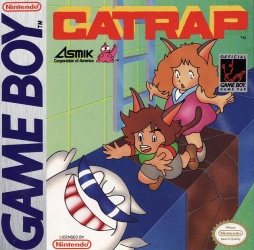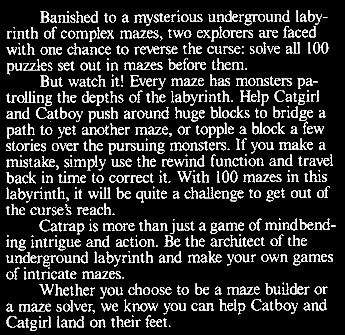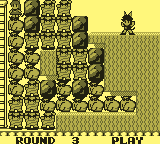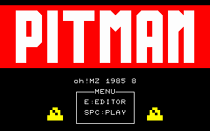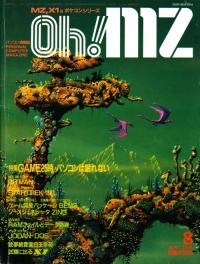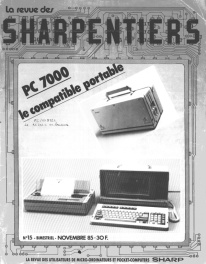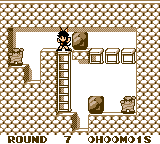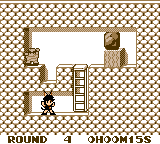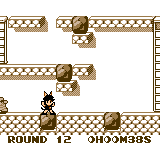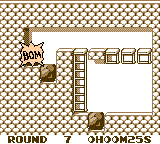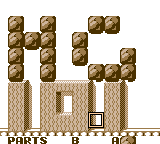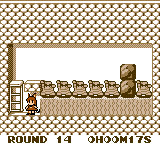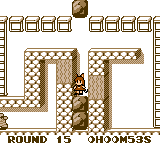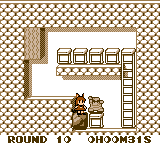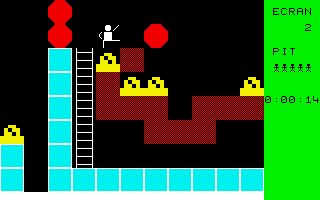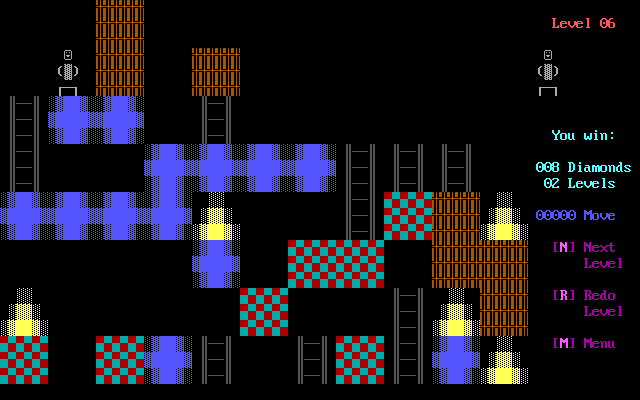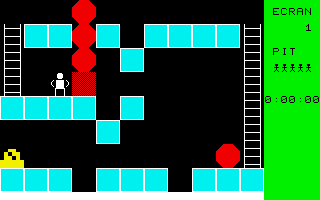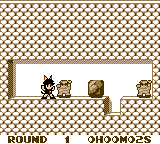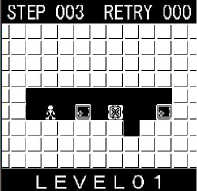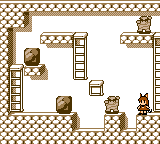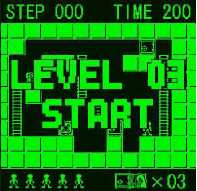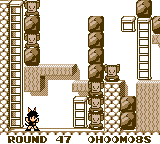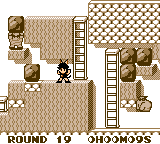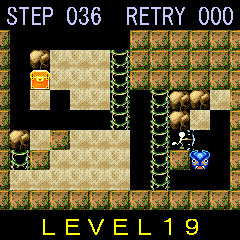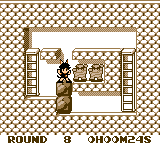
The original monochrome Game Boy is a mostly untapped source of obscure, overlooked and forgotten games, all with the potential for excellence. Noiseredux's site, for example, does a fine job documenting some of these and highlighting the extent of the library. But even when niche GB titles are covered, it's often difficult to research their history - with HG101's feature on Mercenary Force it wasn't obvious which of the three companies on the splash screen were developer, publisher and miscellaneous. Catrap, known in Japan as Pitman, has an especially unusual background - it's also one of the finest GB games you've probably never played.
It's not the most obscure game we've featured, since there are other sites covering it. Some describe it as a cross between Sokoban and Boulderdash. Others claim it's a predecessor to Braid, citing its rewind feature and the time travel description on the back of the box. They're all good descriptions, though Catrap's later levels are intricate to the point of being more like chronologically-specific jigsaw puzzles, making the time travel description slightly erroneous. After all, board games such as Othello and Chess have undo options, but these aren't time travel. Another good game to put it alongside would be Kwirk on the GB from 1989, which featured similar-ish gameplay and dual characters.
On the GB version of Catrap / Pitman you take the role of either Catboy or Catgirl, and in some stages both, to solve 100 puzzle rooms and the game. It's all facilitated by the following story:
Completing levels involves touching from the sides all creatures therein, whereupon they disappear and the level ends. Creatures take the form of mummies, Frankenstein monsters, ghosts and others. To facilitate touching you need to push blocks into pits, dig through soft earth and climb ladders. Monsters can hold up blocks, so when dissolving them it's important to consider if the resulting landslide will trap you. Ghosts meanwhile will float in the air, sometimes requiring clever thinking to build paths to them. Creatures cannot be dissolved by touching them from above or below (though they do make great platforms!) A quick glance at the pictures around this page should give an idea of how the game plays out. At any time you can hit a button on the GB and rewind your previous moves.
The first 15 levels start out insultingly easy, acting more like a tutorial, and then quickly ramp up in difficulty, with level 100 only unlocked after the previous 99 have been finished. Until that point you can attempt levels 1-99 in any order, with progress recorded via password. Level 100 proves especially challenging. You can also create your own levels using the handy in-game level editor. These can't be saved in the traditional sense, and instead the game generates a password (up to a maximum of 60 characters) allowing you to recreate any levels you're especially proud of.
From level 30 onwards you also sporadically come across levels which include both Catboy and Catgirl, who can be switched between via the select button. They need to help each other, tag-team style, to touch all the monsters. In this way it's similar to that other GB game Kwirk, where you needed to use two characters in tandem to solve the mazes. Except Catrap predates Kwirk by around four years.
The three secret rounds accessible only via code.
An interesting difference is between the Japanese and later US release, for Round 60. This was pointed out by MP83 who atempted to screengrab all 100 levels, should anyone want to make an updated remake on modern platforms. Owning the Japanese version, he also noted that the manual had codes for three secret bonus rounds. Apparently the codes in the US manual are wrong, though correct codes were printed in Nintendo Power at the time - it wasn't just the cover art they butchered in the localisation! MP83 also provided scans of artwork from the manual (including what appears to be Catgirl attacking a ghost with flatulence). Art 1, Art 2, Art 3, Art 4, Art 5, Art 6.
History
Yutaka Isokawa
Pitman, as it was originally called, was created in 1985 by Yutaka Isokawa using only Hudson's HuBASIC, on the Sharp MZ-700. In August 1985 its BASIC listing was featured in Oh!MZ magazine, a publication dedicated to said computer range. Hardcore Gaming 101 has acquired a copy of the magazine to preserve a scan of the original listing. Isokawa also released an updated version for Oh!MZ magazine in November 1985, listed in the table of contents as Pitman Plus (PITMAN プラス). This appeared alongside two more updates by other programmers (whose names are unfortunately illegible on the only available scans), PITMAN2000 and PITGAL. Could the latter one have anything to do with Catrap's two-character stages?
Sharp's MZ range started in 1979 (the 700 model came out in 1982) and is fairly obscure, as detailed by Forster's Encyclopaedia of Games machines, which states that only 150 games were developed for it. It appears, however, that the figure would only include commercial games and not the many BASIC listings, which weren't confined to Japanese magazines like Oh!MZ. In 1980, the Sharp Users Club was founded in the UK, at Yeovil College. By the end of 1981, the club had grown to hold more than 500 members, not only in the UK, but also France, Belgium, West Germany and Japan, and continues to publish their own magazine even today. France also got its own Sharp User's Club, the Sharpentiers, lead by one Sylvaine Bizoirre from 1982 to 1986. Printed in the November 1985 issue of the club's magazine La revue des Sharpentiers, PITMAN even made it to Europe, in a modified version for the more common S-Basic.
The french publication actually led to some uncertainty concerning the game's origin later, when Bizoirre accompanied his own little BASIC compiler called MBasic with a new version of Pitman, omitting Isokawa's credits and introducing it as a game he himself wrote for the Sharp MZ-80K in March 1984 for unknown reasons. Bizoirre has cut his ties to the retro computer comunnity, so his motivations will likely remain a secret.
Thanks to the work of community member BdR, everyone can now try out the original MZ-700 Pitman - well, almost the original, as the code is based on the Sharpentiers S-Basic version with French screentexts. Be sure to also bookmark BdR's homepage in case of possible future updates.
Nonetheless Pitman is certainly obscure enough that finding info or even screens of the original game was difficult. Isokawa's bibliography page, while listing Pitman as his first game, doesn't even have a picture. Looking through the bibliography it's interesting to note that of all his later work, none was as memorable as Pitman (though he does appear to have programmed the menus for the 32-bit Lunar games, and worked on a few Gundam titles). His latest work appears to be some kind of Gundam strategy sim. A Japanese fellow by the name of Szkktht was evidently keen on the original BASIC Pitman, since his fanpage contains perhaps the only screens online.
So popular was the original BASIC-coded Pitman that in 1990 it was officially remade for the GB, undergoing a cosmetic transformation to feature its two anthropomorphic characters instead of an archaeological explorer. Generic treasures were also replaced with monsters. The GB version doubled the amount of stages from 50 in the original to 100. Most of them are new, reprising only a handful from the MZ-700 game. Later it was localized into English and released as Catrap in the US. Several British magazines in the early 1990s also ran reviews of a GB game called Power Paws, a renamed version of Catrap intended for local release. All evidence points to it never officially coming out despite the reviews. HERE is a review of Power Paws from Game Zone magazine, No. 10 Vol II, August 1993. Other magazines which covered it were CVG 141 (August 1993).
Quick Info:
|
Developer: |
|
|
Publisher: |
|
|
Designer: |
|
|
Genre: |
|
|
Themes: |
Catrap (Game Boy)
Catrap (Game Boy)
Catrap (Game Boy)
Catrap (Game Boy)
Catrap (Game Boy)
Catrap (Game Boy)
Catrap (Game Boy)
Catrap (Game Boy)
Catrap (Game Boy)
Catrap (Game Boy)
Such a fan was Mr Szkktht, that he made a homebrew port/remake for the GBA. In lieu of the original MZ-700 version to test, this close remake gives clues as to any changes that might have taken place when ported to the original GB. Szkktht's version features 100 levels, and 10-59 are exact recreations from the original. If it is as close a port as it claims, then the original MZ-700 game was fairly different to its subsequent GB port, not just in aesthetics but also the block physics, which in the GBA game are sometimes suspended high in the air until you pass beneath them. There is also no rewind feature, making this version extremely frustrating to play.
Sylvain Bizzoire's version from 2001 clearly was just meant as a little program to demo MBasic; it only includes the first 22 stages. Based on this version is also a DOS-port made by Tristar (which has since been updated to contain all 50 original levels, but omits the editor).
In 2004 there was a series of official remakes for Japanese mobile phones, directly involving Isokawa, under the name Pitmania. The first two have monochrome graphics and 50 stages each, putting them in line with the MZ-700 original, while the subsequent 2007 Pitmania Infinite release features the game in colour and compiles all 100 stages. As can be seen, these mobile phone remakes closely match the original GB version's level structure.
With the entire series receiving little fanfare over the years, it's unlikely we'll see any of the newer additions in the west - though some form of iPhone app would be perfect. Regardless, these are still extremely fun games, perfectly suited to play in quick bursts while on the go. Even if you can't get one of the newer versions, the original GB release with its anthropomorphic characters and nauseatingly saccharin music has a tremendously lovable charm to it.
The original GB game is now available on the 3DS Virtual Console, under the name Catrap, for $2.99 / £2.70.
Comparison Screenshots
Mobile versions comparisons

